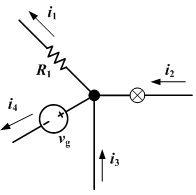Kirchhoff's circuit laws facts for kids
In 1845, a German scientist named Gustav Kirchhoff came up with two important rules about electrical circuits. These rules help us understand how electricity moves and behaves in wires and electronic devices. They are super helpful for anyone working with circuits!
Contents
Kirchhoff's First Rule: Current Flow
Kirchhoff's first rule is also called the current law or junction law. Imagine a place where several wires meet, like a crossroads for electricity. This meeting point is called a junction.
This rule says that the total amount of electric current flowing into a junction must be equal to the total amount of current flowing out of that junction. Think of it like water flowing through pipes: if 10 liters of water flow into a pipe junction, then 10 liters must flow out. No water disappears, and no new water suddenly appears!
This rule is based on the idea that electric charge cannot be created or destroyed at a junction. It just moves around. The picture on the right shows an example: the current i2 and i3 flow into the junction, and then they split into i1 and i4. So, i1 + i4 will always equal i2 + i3.
Kirchhoff's Second Rule: Voltage in a Loop

Kirchhoff's second rule is also known as the voltage law or loop law. A loop in a circuit is any closed path that electricity can follow, starting from one point and returning to the same point without lifting your "finger" from the path.
This rule states that if you add up all the voltage "pushes" and "drops" around any closed loop in a circuit, the total sum will always be zero. Think of voltage as the electrical "pressure" or "energy" that makes current flow.
Imagine you start at one point in a circuit loop and go around it, adding up all the voltage increases (like from a battery) and voltage decreases (like across a light bulb). When you get back to where you started, the total change in voltage will be zero. It's like climbing up and down hills: if you start at your house, walk around, and come back to your house, your total change in height is zero.
This rule is based on the idea that energy is conserved. The energy given by a power source (like a battery) is used up by the components in the circuit (like resistors or lights).
Images for kids
See also
 In Spanish: Leyes de Kirchhoff para niños
In Spanish: Leyes de Kirchhoff para niños


